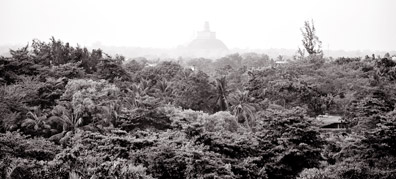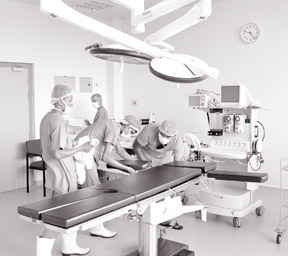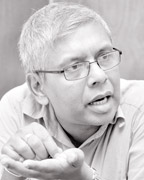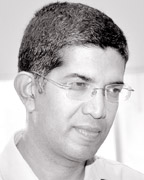Rajarata University opens Medical and Allied Sciences Faculty amidst
challenges
By Dhaneshi Yatawara
|

A panoromic view of the Anuradhapura stupas from the theatre.
|
A few days ago the first batch of doctors passed out from the
youngest Medical faculty of the country joined the National Health
Service. Started with fragments of a faculty, these students achieved
their aim with sheer dedication and courage in due course creating a
fully fledged medical faculty that was created in the recent past of the
history in Sri Lanka.
A medical student comes with dreams, aspirations and with a load of
expectations about their future. While convincing such youth about the
brighter side of a growing up faculty, heads, professors and lecturers
who were appointed to head of the Medical and Allied Sciences Faculty of
the Rajarata University had a tough time in the process.
|

State-of-the-art operation theatre |
"First we had students and then came the rest of the segments of the
medical faculty," said Dean of the Faculty Professor Malini Udupihilla
"The first building we had was that of a previous youth program and the
entire building needed to be refurbished to suit the environment of a
medical faculty. And that was very difficult. We had only few lecturers
- people who were retired from the University of Peradeniya were
recruited. So we all had to do everything basically," said Prof.
Udupihilla.
At the start in September 2006 the faculty did not have either labs
or furniture - just students and lecturers. "Since then we were building
up gradually and at present we can be satisfied with the development of
infrastructure, labs and many other facilities. But our problem at the
moment is the recruitment of staff. We need more lecturers. Especially
at senior level," she added. As she pointed out a remedy is needed for
the problems lecturers facing in admitting their own children in to
schools and of course a lecturer for this university should be a person
who would love to live in a quiet and slow moving life in Anuradhapura.
 |
 |
 |
|
State-of-the-art operation theatre |
Dr. Sujeewa Thalgaspitiya |
Dr. Sujeewa Thalgaspitiya |
"Though all medical schools provide doctors for the national service,
we at the Rajarata University try to lead medical students in a
direction which might be beneficial to the people in the North Central
Province. We are specially concentrating on issues like chronic renal
disease and snake venom poisoning. And also we have set up a Research
Centre for Ayurveda," she said.
The University takes 180 students annually and they have about 30 -
35 lecturers at the moment. As Prof. Udupihilla said when some of the
lecturers go on study leave and the shortage of staff created by this
becomes a big problem as replacements are difficult. "We have informed
the Higher Education Minister on these matters and promised to look in
to these issues," she said.
Yet, for these almost seven years this medical school has done pretty
well," said Prof. Udupihilla.
"The first batch graduated and the results were quite satisfactory.
In spite of all the problems students have done well. Only two students
failed and 25 are being referred. All the others passed. We had fifteen
upper seconds and fifty lower seconds out of the total 164 students who
sat for exams," Prof. Udupihilla said.
Great start
 |
|
Dilan Senevirathne,
Rivikelum Samarasinghe, Damitha Abeysinghe, Upeksha
Wickramasinghe, Gihan Thenuwara |
Since this is a state university the recognition of the degree is the
same. "Our academics are trying to work on building connections with
foreign universities with better facilities in order to broaden the
research and academic aspects," she said.
"Although we started with great difficulty, the students of the first
batch showed good results. We have ten distinctions in Medicine. Only
five failed in medicines as a subject. Totally we have about 26 failures
out of 164 students. Two distinctions in Obstetrics Gynaecology, one
distinction in paediatrics and one distinction in surgery," said
Professor Sisira Siribaddana, a founder professor of Medicine and Chair,
Department of Medicine.
As Professor Siribaddana said, the faculty has four senior consultant
grade medical professionals to teach medical students as well as post
grads.
"We have a heavy work load at the faculty; apart from studies we
treat patients. Every third day we are on call. We get patients with
ailments that give examples throughout the medical spectrum - three or
four snake bites, some with leptospirosis, 5 -10 patients with heart
disease or problems, poisoning etc.," he said. And also the hospital
gets patients transferred from areas like Mannar, Vavuniya, Dambulla,
Kebitigollewa, Padaviya and Sripura hospitals as well.
Following the establishment of the faculty a new professorial unit
was established within the Auradhapura University and almost all medical
facilities are available at the professorial unit of the Anuradhapura
hospital to teach students.
The start was very difficult for the staff as well as students.
Everyone had to make sacrifices and adjust themselves to this developing
environment," said Dr. Niroshana Dassanayake, one of the first senior
lecturers to join the faculty.
A faculty is not of professors, lecturers, buildings and labs. Its
main component is students. A successful batch of students is the sign
of success of the faculty.
Speaking of the rough patch of history they went through Dilan
Senevirathne, Rivikelum Samarasinghe, Damitha Abeysinghe, Upeksha
Wickramasinghe, Gihan Thenuwara explained about the transformation
representing their entire batch.
After being eligible for university study we were the students left
without a medical faculty. We accepted it as we needed to start our
higher studies. Studying was a big battle for us," said Dilan. And as
Gihan added we were about to enter a faculty that was only suggested at
that stage. Yet they succeeded though the first days, months were really
hard for these students. They had only one building and no canteens or
libraries. "Sometimes we had to buy those books that were needed for
references until a library was established after five months," Gihan
said.
What was the positive factor that kept these youth in this emerging
medical faculty? According to them they knew after some time it would be
easier. "We went through harsh situations together. We faced challenges
as one team - the entire batch," they said.
How do they compare themselves and see where they are now? "Comparing
ourselves to students who passed out from other medical faculties
knowledge and skills we don't have any differences. Our lecturers were
with us at all times - when we went through all the difficulties in
trying to do our studies best. They dedicated so much time for us.
Looking back, we see so many achievements in our struggle to study.
Those hardships made us strong - professionally and personally," they
said.
The Anuradhapura Hospital is added with a state-of-the-art
professorial unit with the establishment of the Medical faculty at the
Rajarata University.
Two high-tech theatres
According to Surgeon Dr. Sujeewa Thalgaspitiya, Head of the
Department of Surgery, the unique feature of the unit is its two
high-tech theatres. "At emergencies we cannot let patients wait as at
times surgery can save a life. So for a hospital like this two
state-of-the-art theatres mean more possibilities of saving lives," said
Dr. Thalgaspitiya.
In addition to this benefit surgeons like Dr. Thalgaspitiya and
researchers of the Medical Faculty are conducting research on various
aspects of surgeries including finding correct paths to inculcate
traditional medicinal knowledge in surgeries to the modern.
Colombo and Kandy cities are developed in the country as health hubs.
Because all these places have developed with a faculty, said Dr.
Darshana Sirisena, Consultant Neurologist of the Anuradhapura Hospital.
"When we take patient care wise Anuradhapura is the health hub, not only
for the North Central Province but for North Province, Eastern Province
as well. By being affiliated with the Medical Faculty this major
hospital gets many benefits. Quality of patient care and health
facilities gets improved," he said. "North Central Province has a unique
illness that was neglected in the past. So being affiliated to the
faculty a lot of scientists interested in such research get a better
opportunity to carry out their research, thus giving a clear picture of
many such unique instances. Along with the lot of facilities available
with hospital, this collaboration can bring a big change in the medical
field," he said. |


